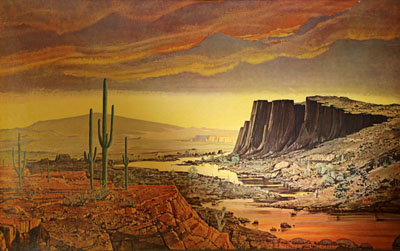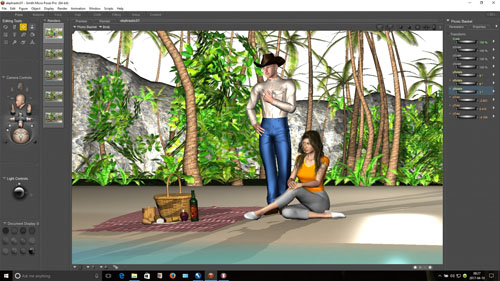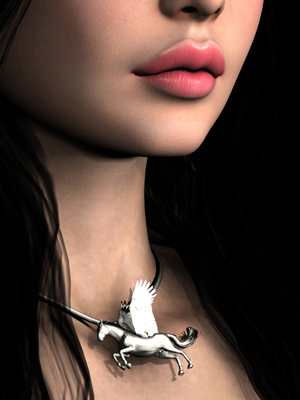Ekphastic Poser
Posted: 6 January 2017
The classic question that poets, other writers, and probably any other creative persons get asked is "Where do you get your ideas?" I'd guess that we all have a variety of answers because ideas can come from a multitude of places.
 Janet presented a program to our South Arkansas Writers (SAW) group a while back about "Ekphrastic Poetry" - poetry inspired by a work of art. But ekphrastic isn't just an adjective for poetry. I have a print of a painting that could only have been inspired by the old western song, "Riding Down the Canyon" and the challenge expressed in the line, "A picture that no artist e're could paint." So any creative work could be inspired by some other. I'm sure that we can have ekphrastic poetry, ekphrastic paintings, ekphrastic songs, ekphrastic you-name-it. Ekphrasis can be a two-way street where creativity is concerned - a painting inspires a song, a song inspires a painting, etc.
Janet presented a program to our South Arkansas Writers (SAW) group a while back about "Ekphrastic Poetry" - poetry inspired by a work of art. But ekphrastic isn't just an adjective for poetry. I have a print of a painting that could only have been inspired by the old western song, "Riding Down the Canyon" and the challenge expressed in the line, "A picture that no artist e're could paint." So any creative work could be inspired by some other. I'm sure that we can have ekphrastic poetry, ekphrastic paintings, ekphrastic songs, ekphrastic you-name-it. Ekphrasis can be a two-way street where creativity is concerned - a painting inspires a song, a song inspires a painting, etc.
The images that I create with the 3D computer graphics program, Poser, are examples of the two-way street of ekphrasis. Since I sometimes bring pictures related to my stories or poetry to our SAW meetings, one of the members suggested that I explain a bit about how I use Poser. That program is the basis of this "Ekphastic Poser" post because I've found a very strong interaction between my writing and my Poser images.
Let's start with how I use Poser to create an image.
If I was the producer or director of a traditional movie, play or TV show, I would hire actors and actresses, dress them in the appropriate costumes, see that they were properly coifed, make sure they had the necessary props, and pose them in an indoor or outdoor setting. I would arrange the lights and cameras to produce the desired effect. Poser is a computer program that allows me to create images in much the same way.
When you open Poser you see a blank window surrounded by a variety of controls and tools. The things that I need as a "Producer/Director" are filed in various categories of the program's Library. Male and female humans (and aliens), as well as an assortment of animals, birds, trees, flowers, etc. are available.  Clothing and hair styles are provided. A variety of "sets," both indoors and out, can be loaded. The characters can be posed and placed wherever desired in the sets. Other props can be added. Lights and cameras can be adjusted. Up to this point, the characters, props, and sets are displayed in the window in a fairly descent, but somewhat crude, fashion. Clicking the "Render" button results in the image being recreated, block by block, row by row, more realistically. You can save the image and/or go back and make some changes to the scene.
Clothing and hair styles are provided. A variety of "sets," both indoors and out, can be loaded. The characters can be posed and placed wherever desired in the sets. Other props can be added. Lights and cameras can be adjusted. Up to this point, the characters, props, and sets are displayed in the window in a fairly descent, but somewhat crude, fashion. Clicking the "Render" button results in the image being recreated, block by block, row by row, more realistically. You can save the image and/or go back and make some changes to the scene.
Some characters, props, etc. come with Poser. Many others are available from an assortment of online merchants. Costs range from just a few dollars to over $50, depending on how complex the model is. Sometimes preexisting models can be combined to create new models - like the Pegasus pendant that I created from a horse, a pair of wings, and a silver color.
So where did my title, "Ekphrastic Poser," come from? Well, sometimes one of my stories suggests a scene to create with Poser. Sometimes an image I've created with Poser suggests a story. Sometimes a model that I find at one of the online sites suggests a story, an image, or both. Ekphasis.
As I suggested before, ekphrasis can be a two-way street. When creating an image of Bidido, one of my villains, I had to give him an eyepatch. When I looked in my stories, I discovered that sometimes the patch was over the right eye, sometimes the left. (Perhaps he didn't want to show favoritism.) So I made up my mind that it covered the right eye and corrected all the stories in error. Ekphasis: a story is influenced by a Poser image.
 In my story, "Thixotropic", Zenith Warren had a necklace with a silver pendant of Pegasus. Ekphasis: The story inspired me to create an image of the necklace and pendant. But I didn't have a necklace model long enough to allow her to pull the necklace over her head to remove it, as described in the story. So, for the image, I used a shorter necklace that she could remove by undoing a clasp. I rewrote that bit of the story. Ekphasis: The image influencing the story.
In my story, "Thixotropic", Zenith Warren had a necklace with a silver pendant of Pegasus. Ekphasis: The story inspired me to create an image of the necklace and pendant. But I didn't have a necklace model long enough to allow her to pull the necklace over her head to remove it, as described in the story. So, for the image, I used a shorter necklace that she could remove by undoing a clasp. I rewrote that bit of the story. Ekphasis: The image influencing the story.
These back and forth changes happen quite frequently. Sometimes I have to search for or create a model that I don't have in order to fit a story. Sometimes the availability of a model unlike that described in a story requires that I have to do some rewriting.
I enjoy writing. I enjoy creating 3D graphics images. When an ekphrastic relationship develops between the two, it can be especially fun.